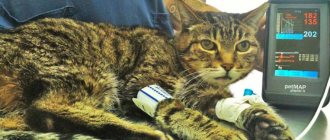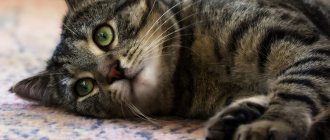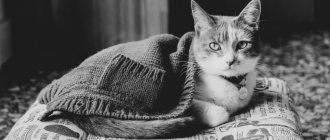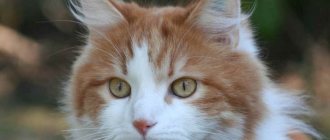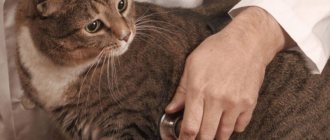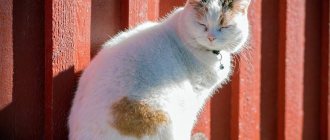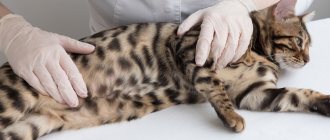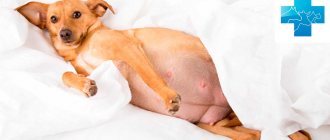If your cat is constipated, treatment should begin with a change in diet. Quite often, in the absence of serious pathologies, this measure is enough to establish bowel movements. The first step is to introduce more fiber-rich foods into your cat's diet. Coarse plant fibers perfectly stimulate the intestines and make them contract.
The basic rules of the diet for constipation depend on the diagnosis. To diagnose it and prescribe appropriate treatment, you must contact a veterinary clinic.
Constipation due to pancreatitis and changing the cat's diet
One of the causes of constipation in a cat may be inflammation of the pancreas - pancreatitis. This disease can occur in isolation, but more often it indicates other gastrointestinal pathologies. The disease is manifested by alternating constipation and diarrhea, vomiting after eating. The cat has a bloated stomach, which also hurts. With this disease, the following feeding rules must be observed:
- exclusion of fatty foods from the diet;
- It is strictly unacceptable to give an animal fried food, especially from the human table;
- milk and dairy products are excluded;
- the bulk of the diet should be meat by-products, as well as fiber-rich vegetables;
- Meat should not be given raw, it must be cooked.
Also read the article about what you should never feed cats.
The doctor also prescribes drug treatment for pancreatitis. The tablets should be given to the cat with food. It is also recommended to conduct a course of vitamin and mineral supplementation.
Disorderly feeding
It is not uncommon for a pet to receive a wide variety of food as treats every day: meat and fish, sausages, dairy products, eggs, cereals, bread and even sweets. But when asked what the animal is fed, the owner confidently answers that it is exclusively dry food, since he considers all these delicacies to be something insignificant. In fact, such disordered feeding often causes digestive disorders, which can include both diarrhea and constipation.
Intestinal blockage as a cause of constipation and proper nutrition
If the cause of constipation is a blockage in the intestines, this causes great suffering to the cat. As a rule, her stomach is swollen, there is colic, and she vomits after eating. If defecation occurs, it is in small portions and blood impurities may be found in the stool. In such cases, veterinarians recommend an enema, intestinal lavage, and drug treatment. For better fecal movement, you can give your cat a little vegetable oil (2-3 drops per meal). To solve the problem of constipation, it is necessary to make the following changes in diet:
- normalization of the ratio in the diet of BZHU;
- Be sure to include vegetables containing fiber in your diet;
- food should be well chopped, thermally processed, and have a normal temperature.
Cats with these problems definitely need to drink plenty of water.
Worm infestations
If you neglect anthelmintic prophylaxis (ideally, it should be carried out quarterly), the risk of worms appearing in the intestines is very high. When the number of helminths goes off scale, they prevent stool from moving forward normally, thereby causing constipation. In such a situation, it is too late to remove the worms on your own: it is wiser to contact a veterinarian, who will prescribe a step-by-step treatment regimen. The simultaneous death of a large number of parasites can cause poisoning by decay products and cause even greater harm.
Diet for obesity as a cause of constipation
If a cat has constipation, not accompanied by other symptoms (vomiting, restlessness, blood in the stool), while she is overweight and moves little, then the reason is obesity. In this case, constipation occurs very often and lasts for a long time, so the cat definitely needs help. It is recommended to do enemas, and it is also recommended to achieve weight loss through diet. Its rules:
- reducing the proportion of simple carbohydrates in the diet;
- The cat should be fed only dietary varieties of meat and poultry (chicken, rabbit, beef, lean veal);
- the meat must be frozen well, and meat by-products must be given to the animal only in boiled form, having previously been scalded with boiling water;
- vegetables should be raw, as heat treatment can increase their calorie content.
An obese cat should be fed frequently, in small portions, so that it does not feel hungry and therefore does not have the desire to overeat. You should also involve your pet in outdoor games and create conditions for him to be active.
We recommend reading the article about a proper cat diet.
Negative symptoms
With this pathology, the pet may visit its litter box frequently and to no avail.
Cats suffering from constipation typically exhibit the following symptoms:
- lethargy;
- pain when pressing on the stomach;
- loss of appetite;
- vomit;
- nausea;
- belching;
- frequent sitting in the tray;
- bloating and hardening of the tummy;
- attempts to avoid contact with people;
- temperature increase.
Supplements and Foods to Help Relieve Constipation
In addition to following a diet and taking medications prescribed by your doctor, certain food supplements can help your cat cope with constipation.
Experts recommend introducing magnesium-rich foods into your diet. This element promotes better bowel function by stimulating its contractile movements.
However, owners of neutered cats should remember that excess magnesium in the body significantly increases the risk of developing urolithiasis.
A good laxative is raw chicken liver. Also, with mechanical constipation, you can increase the proportion of fats in the diet for a short period of time. Lipids will make stool softer, making it easier to move through the digestive tract. It is not necessary to introduce fatty meats into the diet; it is better to provide her body with vegetable fats. To do this, add a few drops of olive or flaxseed oil to the food.
Many experts say that pumpkin is a good remedy for constipation. This vegetable contains coarse fibers that stimulate intestinal motility. There is no scientific evidence of the effectiveness of using pumpkin for constipation in cats, but experience shows that this method is safe and works well to cope with stool disorders.
In addition to pumpkin, you can give your cat other vegetables. Usually these animals do not like such food, especially if they are not accustomed to it from an early age. You can introduce vegetables into your diet by gradually adding them to cottage cheese, mixing them into meat dishes and porridges.
For good functioning of the intestinal tract, you can give your cat grass. In nature, they find the plants they need on their own. In an apartment, the pet is offered specially sprouted greens, which can be purchased at pet stores.
Many cats do not refuse sunflower seeds. There is no need to fry them; they should be given raw. You can mix them into food after grinding them first. The seeds contain a large amount of fats and vitamins that will help improve the digestion process.
To treat and prevent constipation, you can give your cat a decoction of flax seeds. This remedy helps both people and cats. The seed must be filled with water and boiled well, otherwise toxic substances will remain in the liquid that will harm the cat.
Bran also helps stimulate peristalsis. Once in the intestines, these products act like a brush, stimulating contractions of the intestinal walls. Wheat or oat bran is added little by little to main dishes.
Modern problems of complex therapy of constipation
Constipation is a decrease in the frequency of stools and difficulty in defecating, usually for two days or more, which can lead to pain, discomfort in the abdomen, subsequent obstruction of the intestinal lumen and, rarely, perforation. The term “constipation” is understood as a persistent or intermittent dysfunction of the colon with a decrease in stool less than three times a week and with forced straining, occupying more than 25% of the time of defecation. Constipation is a common and usually subjective complaint. Predisposing factors include physical inactivity, refined, easily digestible foods, and inadequate timing of bowel movements. According to statistics, 30–50% of the adult population suffers from constipation. They are leading among the reasons for visiting therapists and gastroenterologists.
Working classification of constipation
- Primary constipation (with intestinal diseases):
A. Functional constipation (“habitual”):
- rectal constipation (dyschezia) - a sharp weakening of the defecation reflex;
- cologenic constipation is a slowdown in the intestinal passage of chyme as a manifestation of dyskinetic disorders.
- B. Organic constipation. Develops with structural lesions of the intestine: colitis, dysbiosis, anal fissure, hemorrhoids, cryptitis, papillitis, cicatricial narrowing of the colon, prolapse of the perineum and prolapse of the rectal mucosa, cancer and other intestinal tumors, elongated colon, idiopathic megacolon.
- Secondary constipation (caused by extraintestinal causes):
- a) reflex (for peptic ulcers, cholecystitis, nephrolithiasis, gynecological diseases);
- b) for diseases of the endocrine (myxedema, diabetes mellitus) and nervous systems (spinal cord diseases, parkinsonism);
- c) metabolic and toxic (porphyria, lead poisoning, anticholinergics, ganglion blockers, iron supplements, diuretics, sedatives);
- d) muscular constipation: damage to the muscles (diaphragm, abdominal wall, anus) involved in the passage of feces and the act of defecation: myopathy, scleroderma, pulmonary emphysema;
- d) psychogenic.
- Idiopathic constipation.
Constipation is divided into acute, which occurred less than three months ago, and chronic, which lasts longer.
Clinic and diagnostics
The frequency of bowel movements can vary: from once every 2-3 days to once a week or less. Feces are usually compacted, dry, have the appearance of balls or lumps, reminiscent of sheep; can be bean-shaped, ribbon-shaped, cord-shaped. Patients may be bothered by pain and a feeling of fullness in the abdomen; relief comes after defecation or passing of gas. Appetite may decrease, belching of air, and bad taste in the mouth may appear. Often the ability to work decreases, headaches, myalgia, nervousness, depressed mood, and sleep disturbances occur. Persistent constipation may be accompanied by skin changes. It becomes pale, yellowish, flabby, and loses elasticity.
The duration of constipation should be clarified. Acute constipation is often “situational”. For example, constipation in tourists, when consuming refined foods, medications, due to emotional factors. They may be associated with exacerbation of chronic diseases of the upper digestive tract (peptic ulcer) or anorectal area (thrombosis of hemorrhoids, anal fissure).
Taking an anamnesis helps in differentiating constipation from transit and evacuation disorders. The first will be supported by a decrease in bowel movements and flatulence. Disorders of the act of defecation can be assumed when there is a feeling of obstruction or incomplete emptying of the rectum, and the need for manual assistance.
A clinical examination of the patient is carried out; digital examination of the rectum, sigmoidoscopy, and irrigoscopy are desirable. In case of chronic constipation, emphasis should be placed on searching for concomitant neuroendocrine disorders, mental disorders, collagenosis, and metabolic pathologies. It is necessary to clarify whether the patient is taking medications and which ones.
For example, with diabetic autonomic neuropathy, constipation occurs in 60% of patients; with pheochromocytoma, they occur no more often than in 15%. Barium sulfate can cause constipation in susceptible individuals after a single dose, but antidepressants only with long-term use.
If the patient’s condition worsens with increasing constipation, weight loss, anemia, it is necessary to exclude a tumor of the colon or internal organs. The diagnostic program is complemented by colonoscopy with targeted biopsy and ultrasound of the abdominal and pelvic organs.
During the first stage of the diagnostic search, it is necessary to exclude tumor and inflammatory diseases, identify endocrine and mental pathologies, and determine megacolon and megarectum. These diseases require fundamentally different treatment and can be diagnosed during examination, colonoscopy or irrigoscopy.
After excluding them, patients can be offered trial therapy, including dietary fiber, motor correctors, and regulation of the urge to defecate. A positive response to treatment allows the diagnosis to be stopped and maintenance therapy to be carried out. Patients with refractory constipation are subject to in-depth examination. The criterion for treatment failure is the lack of positive dynamics when using dietary fiber. In these cases, an intestinal transit study, sphincterometry, and electromyography will be required.
Treatment
Treating constipation is quite a difficult task. Continuous attempts to develop an effective long-acting treatment regimen have not yet yielded results. Obviously, the mechanism that partly explains this fact, and the factor that is most difficult to influence, is the psychosocial environment.
Patients are advised to increase their consumption of wholemeal products, fresh and dried fruits and vegetables, and take more fluids. Patients should avoid taking herbal laxatives and high cleansing enemas. Microenemas of up to 200 ml in volume daily in the morning are acceptable in order to develop the urge to defecate.
Drug therapy is prescribed taking into account the predominance of certain symptoms. Drugs of different groups can be used constantly or as needed, in the latter case it is recommended for patients with periodically occurring symptoms. In patients refractory to treatment, drugs with different mechanisms of action are combined.
Special treatment includes eliminating intestinal obstruction (fecal stones, tumor), avoiding the use of drugs that inhibit peristalsis (antacids containing aluminum and calcium, opiates).
Fiber (dietary fiber) (20–30 g/day) is good for chronic constipation, but it only works after a few weeks and can cause flatulence. Dietary fiber (DF) is a product of plant origin containing non-fermentable substances of a polysaccharide nature - cellulose, hemicellulose, lignin. They regulate the consistency of stool, increase its mass and speed up the movement of contents. PIs bind fatty acids (natural laxatives), delivering them to the colon. People suffering from constipation have insufficient fiber intake or an increased need for dietary fiber. To make up for the daily need for dietary energy, you need to eat up to 1.5 kg of wholemeal bread, cabbage and apples, which is unrealistic for a modern person.
PF includes wheat bran, microcrystalline cellulose (MCC), agar-agar, laminaride, flaxseed. Wheat bran is added to food, and plantain seed is mixed with water and taken 2-4 times a day. It is usually recommended to start taking bran 3 to 6 tablespoons per day with food, pouring boiling water over it. The amount of fluid is increased to 2–3 liters per day.
Wheat bran does not immediately exert its effect; the latent period can be 5–7 days. This is the time required for the bran taken orally to enter the ampulla of the rectum and be ready for defecation.
If the effect is not achieved, it is possible to use MCC at a dose of 4–9 g per day or the preparation from plantain seeds Mucofalk (10–30 g per day). The latter retains liquid more strongly, does not produce intense gas, and is better tolerated by patients. Dietary fiber can be combined. However, their use is limited if the patient is not able to increase fluid intake, which is fraught with the development of obstruction.
Laxatives are prescribed when fiber is ineffective. Their long-term use is undesirable. For abdominal pain of unknown origin or intestinal obstruction, laxatives are contraindicated.
- Softening laxatives: docusate sodium, 50–200 mg orally once daily. Vaseline oil when taken orally and oil enemas, Norgalax, Enimax also have fecal softening properties. For obstruction, the use of petroleum jelly for several days is quite justified. Longer treatment may lead to impaired absorption and granulomatous reactions. Drugs in this group have limited use.
- Agents that stimulate intestinal motility. Long-term use of these drugs is not recommended. Castor oil (15 ml orally) causes rapid emptying of the colon. Bisacodyl is taken in the evening - orally (10–15 mg) or rectally (10 mg suppositories); defecation occurs within 15–60 minutes. Buckthorn and senna extracts induce bowel movements 10–16 hours after ingestion; with long-term use, atony of the colon is possible. The usual dose of buckthorn extract is 5 ml orally once a day; Senna extract is taken 1 tablet orally 1-2 times a day. Sodium picosulfate (Guttalax, Laxigal, Slabilen) is taken starting with 12 drops at night.
The plant origin of laxatives in this group often determines their choice by patients for self-medication. They are also included in many herbal teas. However, their use should be a necessary measure when other methods of normalizing intestinal function have been exhausted. As the duration of their use increases, the effectiveness of treatment decreases, and the chances of normalizing bowel function decrease.
Most patients taking stimulant laxatives report increased abdominal pain. Thus, senna anthraquinones exert their effect through damage to epithelial cells, which leads to impaired absorption, secretion and motility. Melanosis of the mucous membrane is observed, and in a third of patients an “inert” colon is formed. Patients with melanosis have an increased risk of developing carcinoma. However, short-term use may be considered safe. By “strength”, herbal preparations can be arranged as follows: aloe ® senna ® buckthorn ® rhubarb. To a certain extent, the above applies to both bisacodyl and sodium picosulfate. However, the effect of sodium picosulfate is milder. These drugs should be used once every 3-4 days in the minimum effective dose, which will allow you to maintain sensitivity to them for a longer time and avoid negative consequences.
- Osmotic laxatives are non-absorbable salts and carbohydrates that retain fluid in the lumen of the colon. Their immediate effect is higher than the effect of dietary fiber. A number of drugs in this group, like magnesia, are used for a short time when it is necessary to induce rapid bowel movement, for example, to prepare a patient for irrigoscopy, others are intended for prolonged use - lactulose, Forlax. Lactulose is a synthetic, non-absorbable polysaccharide that reaches the ileum, where it is broken down to form lactic and other acids. This leads to a decrease in pH, an increase in osmotic pressure and stimulation of peristalsis. Lactulose (Lactulose, Duphalac, Portalac) at a dose of 30–45 ml per day has an effect after 48 hours, but it is often accompanied by a feeling of bloating and distension in the abdomen. Forlax, a polyethylene glycol with a molecular weight of 4000, has the best tolerability. The drug has no side effects, does not affect microflora, and gives a quick effect. Its use is possible for a number of months and even years. Habituation does not develop. The dose of Forlax ranges from 30 to 60 g per day, and in high doses it is also effective for refractory constipation. Dietary fiber and osmotic laxatives are combined with each other, and the dosage of both can be reduced in combination treatment.
A solution of polyethylene glycol with sulfates and other salts is used to quickly cleanse the colon in preparation for endoscopy or surgery. The solution is taken orally, 4–6 liters over 3–4 hours.
When complaints of bloating and flatulence predominate in the clinic, the prescription of drugs is indicated, the mechanism of action of which is based on reducing the surface tension of gas bubbles, which ensures resorption and free release of gases. One of these drugs is Espumisan (the active ingredient is simethicone). It is not absorbed in the digestive tract and is excreted unchanged from the body. By reducing the surface tension at the interface, simethicone impedes the formation and promotes the destruction of gas bubbles in the nutrient suspension and mucus of the gastrointestinal tract (GIT). The gases released during this process can be absorbed by the intestinal walls or excreted through peristalsis. For flatulence, 2 capsules of simethicone are prescribed 3-5 times a day.
There are 4 generations of PB. The first generation includes monocomponent preparations (Colibacterin, Bifidumbacterin, Lactobacterin) containing one strain of bacteria. Second generation drugs (Baktisubtil, Biosporin and Sporobacterin) are based on microorganisms that are non-specific for humans and are self-eliminating antagonists. They can be used to treat severe forms of dysbiosis, but must be combined with bifido- and lactose-containing PBs, which are necessary to normalize the intestinal microbiocenosis. III generation drugs include multicomponent PBs containing several symbiotic strains of bacteria of the same species (Acilact, Acipol) or different species (Linex, Bifiform) that enhance each other's effects. The benefits of third generation drugs are especially evident in patients with decompensated intestinal dysbiosis. The fourth generation includes preparations of bifid-containing PBs immobilized on a sorbent (Bifidumbacterin forte, Probifor). Sorbed bifidobacteria effectively colonize the intestinal mucosa, providing a more pronounced protective effect than unsorbed analogues.
One of the most frequently prescribed probiotics in Russia is Linex. This is a combined drug containing components of natural microflora from different parts of the intestine. It is used for the prevention and treatment of intestinal dysbiosis, including dysbiosis as a result of treatment with antibiotics, diarrhea, constipation, flatulence, nausea, vomiting, regurgitation, abdominal pain.
Linex Bio is a dietary supplement, a source of probiotic microorganisms, inulin and oligofructose. Combines the properties of pro- and prebiotic agents. Used to prevent the development of intestinal dysbiosis in healthy people.
The balanced composition of Linex is primarily confirmed by the fact that its components allow for the normalization of the functions of all parts of the intestine - from the small intestine to the rectum (enterococci predominantly populate the small intestine, lactobacilli - its lower sections and the large intestine, bifidobacteria - the large intestine).
Bifidobacteria, lactobacilli and non-toxigenic lactic acid enterococcus included in Linex maintain and regulate the physiological balance of intestinal microflora and provide intestinal functions, including motor function, mainly through the production of organic acids and lowering the pH of intestinal contents. Enterococci, in particular, carry out fermentative metabolism, ferment carbohydrates with the formation of lactic acid and also reduce the pH in the intestines to 4.2–4.6. Linex components are also involved in the metabolism of bile acids (in the formation of stercobilin, coprosterol, deoxycholic and lithocholic acids, reabsorption of bile acids). As has long been known, the normal amount and properties of bile have a clear anti-obstipation effect.
The effectiveness of probiotics containing lactobacilli and bifidobacteria, such as Linex, has been demonstrated for irritable bowel syndrome (IBS) with constipation. Treatment led to a decrease in pain and flatulence, and an improvement in the quality of life of patients [Belmer S.V., 2004]. In a clinical study, 4-week therapy with a combination of probiotics similar in composition to Linex (Bifidobacterium, Lactobacillus and Enterococcus) caused a significant improvement in symptoms, especially abdominal pain and stool character, in 74.3% of patients; after cessation of treatment, a stable effect persisted for 2 weeks of observation. In another randomized study, the use of a similar combination made it possible to prolong remission in patients with IBS associated with constipation: exacerbation was observed in only 15% of those receiving probiotics, while in the placebo group - in 100% of cases [Ivashkin V.T., Lapina T.L. ., 2003].
The mechanism of action of Linex for constipation due to IBS remains unclear. It is believed that it may also be associated with its beneficial effect on gas formation in the intestines due to inhibition of the growth of gas-producing microflora.
The duration of Linex therapy depends on the cause of constipation. When using the drug in recommended doses, no side effects were noted. Contraindications: hypersensitivity to the components of the drug or dairy products. The use of Linex is not contraindicated during pregnancy and lactation.
To preserve the viability of the drug components, it is not recommended to take Linex with hot drinks. During the period of using Linex, you should refrain from drinking alcohol.
Colon motility correctors
This group of drugs includes selective antispasmodics and prokinetics. Patients with spastic constipation syndrome have reason to expect success from treatment with antispasmodic drugs (Meteospasmil, Dicetel, Spasmomen, Duspatalin, Buscopan), while prokinetics (cisapride, domperidone) should be used in patients with atonic constipation.
Abdominal pain is eliminated by antispasmodics that regulate, rather than paralyze, intestinal motility. One of them is mebeverine (Duspatalin). The drug acts by reducing the permeability of intestinal smooth muscle cells to Na+. Prescribed 2 tablets or 1 capsule (200 mg) 2 times a day or 1 tablet (135 mg) 3 times a day 20 minutes before meals.
Pinaveria bromide (Dicetel) has an antispasmodic effect by blocking the entry of Ca2+ through calcium channels into intestinal smooth muscle cells. Prescribed 1 tablet (50 mg) 3-4 times a day with meals.
Otilonium bromide (Spazmomen) has an antispasmodic effect as a result of disruption of the mobilization of Ca2+ from the intracellular and extracellular space of intestinal smooth muscle cells without affecting the cell membrane receptors. Prescribed 1-2 tablets (20-40 mg) 2-3 times a day before meals.
Cisapride (Coordinax) , a 5-HT4 serotonin receptor agonist, promotes the release of acetylcholine in the intestinal nerve ganglia. The drug accelerates transit through the colon, stimulates colonic motility, and reduces the sensitivity threshold of the rectum to defecation. However, doses less than 30 mg per day do not have a noticeable effect. Due to the risk of cardiac arrhythmias, it should not be used in elderly patients.
In recent years, new drugs have appeared that selectively act on 5-HT4 receptors, in particular, prucalopride.
In general, serotonergic drugs are considered a promising group of drugs for relieving symptoms of constipation. Serotonin has a pronounced effect on intestinal motility through activation of receptors located on effector cells and in nerve endings. 5-HT3 and 5-HT4 receptors play a leading role in nociception by modulating the afferent side of visceral reflexes. Stimulation of these receptors leads to the release of acetylcholine and substance P, which are transmitters of gastrointestinal sensitivity. 5-HT3 receptor antagonists include motility inhibitors (used for irritable bowel syndrome), while drugs that activate 5-HT4 receptors have a stimulating effect on peristalsis. Currently, the partial 5-HT4 receptor agonist tegaserod is available from this group of drugs.
Biofeedback technique
The main method of treating patients with “exit obstruction” is biofeedback (BFB). Two types of training are described: 1) biofeedback training, in which sensory sensors are placed in the anal canal and monitor the activity of the transverse muscles or pressure in the anal canal, and thus provide feedback to the patient; 2) simulated defecation, in which the patient practices defecation with a simulated stool. Both types of training give up to 85% positive effect. The method is effective not only in patients with defecation disorders, but also in slowing down transit, which is explained by additional psychotherapeutic effects.
Differentiated therapy
For nutritional constipation, it is necessary to increase physical activity and achieve a balanced diet; in more complex cases, use dietary fiber and bacterial preparations (Linex). In patients with gallbladder dysfunction, prescribing a herbal mixture of peppermint, chamomile, immortelle, and tansy will increase the effectiveness of treatment.
For severe constipation while taking opiates, osmotically active agents (lactulose, polyethylene glycol solutions) and emollient laxatives administered orally or rectally (sodium docusate), or mineral oil are effective.
Constipation after cholecystectomy is more difficult to treat. These patients, and equally patients with diabetes, respond better to Forlax. For atonic or slow-transit constipation, cisapride (Coordinax) is used along with dietary fiber or osmotic laxatives. In case of “exit obstruction,” the patient needs additional examination in a hospital setting, as well as trial treatment with biofeedback.
With long-term and long-term use of laxatives containing anthraquinones, their abolition and transfer of patients to dietary fiber and osmotic laxatives is often impossible. In such cases, sodium picosulfate is used once every 2-3 days with increasing intervals between doses and withdrawal. The restructuring of intestinal activity may take 3–6 months. If the abolition of stimulant laxatives is impossible, they take the path of reducing the dose and alternating them. In this case, it is advisable to continue taking dietary fiber.
Patients with abnormally prolonged transit and normal pelvic floor parameters, refractory to drug therapy, are considered candidates for surgical treatment.
Forecast
The prognosis for life is favorable. The course of the disease is chronic, relapsing, slowly progressive. Constipation is rarely complicated by bleeding, perforation, strictures, fistulas, or intestinal obstruction. This determines the tactics for monitoring patients and the lack of need for frequent colonoscopies. The doctor should familiarize patients with the features of the prognosis of the disease, which will improve their psychosocial adaptation.
At the same time, the patients’ ability to work is impaired. As a cause of temporary disability, the diagnosis of constipation syndrome in the world comes in second or third place after acute respiratory infections/ARVI. The quality of life of patients with constipation syndrome in terms of nutrition, sleep, rest, sexual activity, family and social status is reduced.
Literature
- Grigoriev P. Ya., Yakovenko A. V. Clinical gastroenterology. M.: MIA. 2001.
- Zlatkina A. R. Pharmacotherapy of chronic diseases of the digestive system. M.: Medicine, 1998.
- Ivashkin V. T. Irritable bowel syndrome. Practical guide for doctors. M.: RGA, 1999.
- A short guide to gastroenterology. Ed. V. T. Ivashkina, F. I. Komarova, S. I. Rapoport. M.: LLC Publishing House M-Vesti. 2001.
- Bonapace C., Mays D. The effect of mesalamine and nicotine in the treatment of inflammatory bowel disease // Ann. Pharmacother., 1997, 31 (7–8), 907–913.
- Cohen R., Hanauer S. Immunomodulatory agents and other medical therapies in inflammatory bowel disease // Curr. Opin. Gastroenterol., 1995, 11, 321–330.
- Drossman D., Whitehead W., Camilleri M. Irritable bowel syndrome: a technical review for practice guideline development // Gastroenterology, 1997, 112, 2120–2137.
- Hanauer S. Inflammatory bowel disease // N. Engl. J. Med., 1996, 334 (13), 841–848.
- Hanauer S., Schulman M. New therapeutic approaches // Gastroenterol. Clin. North Am., 1995, 24, 523–540.
- Maxwell P., Mendall M., Kumar D. Irritable bowel syndrome // Lancet, 1997, 350, 1691–1695.
- Spencer C., McTavish D. Budesonide. A review of its pharmacological properties and therapeutic efficacy in inflammatory bowel disease // Drugs, 1995, 50 (5), 854–872.
- Thompson W., Creed F., Drossman D. et al. Functional bowel disease and functional abdominal pain // Gastroenterology Int., 1992, 5, 75–91.
V. V. Skvortsov, Doctor of Medical Sciences, Associate Professor A. V. Tumarenko, Candidate of Medical Sciences E. M. Skvortsova O. V. Orlov V. V. Odintsov A. M. Yusupova VolSMU, Volgograd
The role of water in nutrition for constipation
One of the common causes of constipation in cats is dehydration. Evolutionarily, it so happens that cats have almost no feeling of thirst, but they need moisture just like all other living beings. Owners need to ensure that the cat always has access to fresh water.
It is especially important to monitor fluid intake for those who feed their pet dry food.
Cats do not like to drink very much, and if the animal refuses water, then you can pour liquid into its mouth in small portions. This must be done very carefully, making sure that the pet does not choke. For this purpose, you should use a special syringe (or a regular one, but without a needle).
Experts also recommend starting treatment for constipation by increasing the mass fraction of moisture in your pet’s diet. If a cat eats natural food, it usually does not have such problems. But lovers of dry food often suffer from constipation. In such cases, it is necessary to increase the proportion of wet canned food.
The fact is that in cats that constantly eat dry food, especially economy class food, their sugar levels rise significantly due to the excess intake of carbohydrates. The body tries to reduce it through frequent urination, which further increases dehydration.
What should the stool look like?
Cats evolved in the steppe, arid climates of Africa and the Middle East. There's little water there. The cat's body has adapted to save water: cats can limit themselves only to the liquid that they receive from their prey. Therefore, they do not sweat and do not suffer from rapid breathing in the heat, like dogs. And that's why their urine is very dense. The cat's body tries to waste as little fluid as possible. Because of this, cat feces are very hard in their natural environment. It looks more like pellets: whitish or with a yellow tint, crumbly, with an admixture of cat hairs or prey hairs.
This is what normal cat poop looks like
The fewer ingredients a cat digests, the more often it goes to the litter box. Industrial feed contains many ingredients with low nutritional value. Most of the ingredients are poorly absorbed by cats. Therefore, cats that eat dry food go to the litter box more often. Their stool is bulky, loose, and has a pungent odor.
Industrial feeds that normalize stool
For constipation, both acute and chronic, veterinarians recommend feeding your cat medicated food specifically designed to solve the problem. The most effective are the following products:
- Royal Canin FIBER RESPONSE;
- Royal Canin GastroIntestinal;
- ShinyCat Hill's;
- Eukanuba Intestinal;
- Hill's i/d;
- Hills Prescription Diet Feline w/d.
These foods contain all the substances necessary for the treatment and prevention of constipation: fatty acids, fiber, vitamins and minerals.
Having identified symptoms of constipation in a cat, the owner should immediately take measures to eliminate it. If the proposed remedies do not help, then you should show the animal to a veterinarian. It is not worth giving cats human laxatives: the dosages of the active ingredients in such medications are not designed for the weight and functioning of the animal’s body. This can only cause harm. You should examine your pet and strictly adhere to the veterinarian’s recommendations.
1111
Gymnastics
To prevent the pathological condition, walking and running, swimming, exercises to strengthen the abdominal press, squats, and bends are useful.
It is believed that mobile, active children suffer less from constipation. To prevent the pathological condition, walking and running, swimming, exercises to strengthen the abdominal press, squats, and bends are useful.
If your child is already suffering from bowel problems, it is recommended to start the day with simple morning exercises. Massage may also be helpful.
It is important to pay attention to the general change in the baby’s behavior.
The child should be taught to go to the toilet at approximately the same time and encouraged for following the daily routine (motivated and praised).
It is also important to create a favorable environment in the toilet. Nothing should distract the child from the act of defecation or frighten him in the bathroom.
